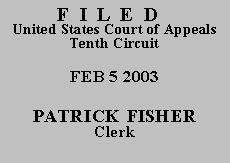

| UNITED STATES OF AMERICA,
Plaintiff - Appellee,
v.
EDWARD L. PYEATT Defendant - Appellant. |
No. 02-2241
D.C. No. CIV-00-1580-JC/DJS and CR-96-228-JC |
In order to obtain a COA, Mr. Pyeatt must establish that "jurists of reason would find it debatable whether the petition states a valid claim of the denial of a constitutional right and that jurists of reason would find it debatable whether the district court was correct in its procedural ruling." Slack v. McDaniel, 529 U.S. 473, 484 (2000).
Where a plain procedural bar is present and the district court is correct to invoke it to dispose of the case, a reasonable jurist could not conclude either that the district court erred in dismissing the petition or that the petitioner should be allowed to proceed further. In such a circumstance, no appeal [is] warranted.
Id. Pursuant to Slack, Mr. Pyeatt's appeal fails.
Mr. Pyeatt was sentenced on December 16, 1996, for various drug and gun possession offenses. Judgment imposing the sentence was entered on January 10, 1997. Mr. Pyeatt did not file any direct appeals challenging his sentence or the underlying conviction. However, on November 6, 2000, he filed a motion to vacate his sentence pursuant to § 2255.
Actions initiated under § 2255 are subject to a one-year period of limitation. As relevant here, "[t]he limitation period shall run from . . . the date on which the judgment of conviction becomes final." 28 U.S.C. § 2255. In United States v. Burch, 202 F.3d 1274 (10th Cir. 2000), we examined when a judgment of conviction becomes final after a petitioner's direct appeal. We reasoned that a "decision of the court of appeals is subject to further review, and therefore not 'final' within the meaning of § 2255 until direct review has been completed." 202 F.3d at 1277 (quoting Kapral v. United States, 166 F.3d 565, 571 (3d Cir. 1999)). We concluded that "a defendant's judgment of conviction was not final for purposes of the one-year limitation period in § 2255 until the time during which she could have filed a petition for writ of certiorari had expired." Id. at 1278.
Here, Mr. Pyeatt did not seek direct appeal of his sentence. Following our analysis in Burch, Mr. Pyeatt's judgment of conviction became final when his claim could no longer be subject to appellate review, which occurred on January 20, 1997, the date his opportunity to file a direct appeal expired. See Fed. R. App. P. 4(b)(1)(A) ("In a criminal case, a defendant's notice of appeal must be filed in the district court within 10 days after the later of: (i) entry of either the judgment or the order being appealed; or (ii) the filing of the government's notice of appeal."). See also Kapral, 166 F.3d at 577 ("If a defendant does not pursue a timely direct appeal to the court of appeals, his or her conviction and sentence become final, and the statute of limitation begins to run, on the date on which the time for filing such an appeal expired."). Pursuant to the one-year limitation period of § 2255, it is clear the district court correctly determined Mr. Pyeatt's claim was untimely. Mr. Pyeatt filed his § 2255 petition on November 6, 2000, nearly four years after his conviction and sentence became final, and well outside the one-year window provided by the statute.(1)
Finally, based on our close review of the Mr. Pyeatt's brief and the entire record on appeal, we agree with the district court that Mr. Pyeatt failed to raise any allegations warranting the application of equitable tolling in this case. See Gibson v. Klinger, 232 F.3d 799, 808 (10th Cir. 2000) (equitable tolling of statute permitted in only rare and exceptional circumstances); United States v. Willis, 202 F.3d 1279, 1281 n.3 (10th Cir. 2000) (case must present extraordinary circumstances to warrant equitable tolling of statute of limitations).
Because reasonable jurists could not conclude the district court erred in dismissing Mr. Pyeatt's action as untimely, we DENY Mr. Pyeatt's application for a COA and DISMISS this appeal.
ENTERED FOR THE COURT
Stephanie K. Seymour
Circuit Judge
*.After examining appellant's brief and the appellate record, this panel has determined unanimously that oral argument would not materially assist the determination of this appeal. See Fed. R. App. P. 34(a)(2) and 10th Cir. R. 34.1(G). The case is therefore submitted without oral argument. This order and judgment is not binding precedent, except under the doctrines of law of the case, res judicata, or collateral estoppel. The court generally disfavors the citation of orders and judgments; nevertheless, an order and judgment may be cited under the terms and conditions of 10th Cir. R. 36.3.
1.We note the magistrate judge calculated Mr. Pyeatt's action time barred on April 10, 1998 (one year after entry of his sentence, plus ninety days in which he could have filed a certiorari petition). See Sup. Ct. R. 13 (petition for writ of certiorari must be filed within ninety days after entry of judgment). Because Mr. Pyeatt did not directly appeal his sentence, however, the proper calculation of the final judgment date is based on the date on which time for filing a direct appeal expired.